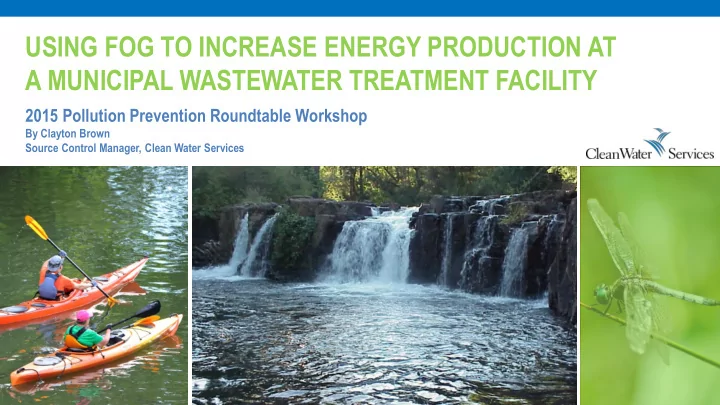

USING FOG TO INCREASE ENERGY PRODUCTION AT A MUNICIPAL WASTEWATER TREATMENT FACILITY 2015 Pollution Prevention Roundtable Workshop By Clayton Brown Source Control Manager, Clean Water Services
CLEAN WATER SERVICES • Established in 1970 • Water resources management utility serving more than 560,000 residents of urban Washington County • 12 Partner Cities • Budget: $64.6M Operating/$66M Capital • Close working relationship with Washington County, but a separately managed and financed public utility
TUALATIN RIVER WATERSHED HILLSBORO FACILITY FOREST ROCK CREEK FACILITY GROVE FACILITY DURHAM FACILITY
TUALATIN RIVER FACTS • Among the first watersheds in the nation with a TMDL — 1988, revised in 2001 • 712-square mile basin, 80-mile river • Only source is rainfall • Cleaned water and release of stored water is nearly 70% of summer flow • Water quality is better than it’s been in decades
CORE BUSINESS AREAS • Resource recovery — treating wastewater to produce: Clean water Fertilizer Energy • Stormwater/surface water management to: Prevent pollution Control drainage Enhance river and stream health Protect fish and wildlife habitat • Water supply Flow monitoring and management Long term planning for regional growth Regional partnerships
DURHAM WWTP ENERGY FACILITY UPGRADE • Replaced a 500 kW energy generation facility with a 1700 kW facility • New facility provides 60% of the energy used at the WWTP (13 million kWh/yr.) • New facility consists of FOG receiving station, FOG storage tanks, gas storage, gas treatment system, two reciprocating engines, generators, and heat recovery system
WHAT IS FOG? • Fats, oils and grease (FOG) from food service establishments • Also known as “brown” grease • Distinguished from “yellow” grease • Caught in grease traps and interceptors before it enters the sanitary sewer system • Often disposed of in landfills
FOG IS A GAME CHANGER • Add FOG to the digesters at Durham, where it will be converted to biogas • Biogas will be burned in the new cogeneration facility, where it will produce electricity and heat • FOG will help the Durham plant triple its energy production
FATS AND GREASE ARE THE BEST WASTE FOR MAKING BIOGAS Cubic meters of biogas production per ton of substrate
CWS tested FOG and Outcome: FOG produced food waste from a local more than twice as much food processor at scale biogas as the food waste
HOW DO WE GET FOG? • FSEs contract with FOG haulers to clean their grease removal devices • The FOG haulers have to dispose of the waste somewhere — why not here? • Two options: 1) Develop an R&O and hang up a “we’re open” sign OR 2) Award contracts to selected haulers
FOG TO ENERGY PROCESS FOG Trucks →→ FOG Receiving Station →→ FOG Storage Tanks →→ Digester →→ Biogas →→ Biogas Storage →→ Engine Generators →→ Electricity and Heat →→ Treatment Plant Operations
HOW MUCH FOG DO WE NEED? • 100,000 gallons per week (at 7% solids) • About three 5000 gallon truck loads per day
RFP HIGHLIGHTS • All proposers must be Preferred Pumpers • Proposers submitted: A) proposed price B) weekly volume range • Contractors selected based on goals of maximizing revenue and maintaining stable FOG supply
FOG ECONOMICS • CHP project construction cost: $14.6 million • Grants received: $5.8 million • Expected tipping fee revenue: $350,000/yr. • Avoided power/heating costs: $800,000/yr. • Simple payback (including O&M cost): 9 yrs.
FOG CHALLENGES • Variables outside of hauler control impact reliability of supply • FOG haulers cannot guarantee a specific quantity on a specific date • CWS uses large FOG storage tanks (70,000 gallons) to compensate for this
FOG CHALLENGES • FOG loads are highly variable in volatile solids content • Energy content is a function of volatile solids content • CWS uses large storage tanks to blend several loads at a time Percent Volatile Solids
FOG CHALLENGES • FOG can contain contaminants that are capable of causing damage to pumps and other treatment equipment • These include chunks of concrete from FOG interceptors, bones, eating utensils, and rags • CWS has equipment that is designed to manage contaminants, including a “rock trap”
FOG CHALLENGES • Digester upsets can occur • A digester is a biological system • Adding FOG to a digester is like eating rich food • Digester conditions must be monitored at all times and adjustments made to FOG feed rates when conditions require
IDEAS FOR USING FOG-TO-ENERGY PROGRAMS to Improve FOG Management • Require contract FOG haulers to be in the Preferred Pumper Program • Establish a fund from FOG tipping fees to assist restaurants with GRD upgrades • Charge lower tipping fees to haulers serving restaurants that meet certain standards • Use tipping fee revenue to increase staffing for regulatory oversight
City of Gresham’s wastewater plant accepts FOG, generates about 18,000 kilowatt/hours per day, and is now energy independent
QUESTIONS?
Recommend
More recommend